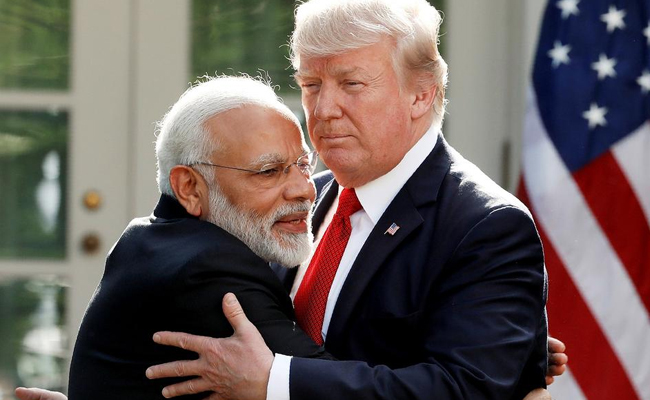The first meeting between Indian Prime Minister Narendra Modi (Modi 3.0) and U.S. President Donald Trump (Trump 2.0) turned out to be a major success. Both leaders agreed to double India-U.S. bilateral trade to $500 billion by 2030. As part of this vision, the U.S. will supply advanced F-35 stealth fighter jets to India and significantly boost defense exports. Additionally, America will increase the supply of crude oil and natural gas to India, strengthening energy cooperation. The two nations will also deepen their civil nuclear partnership.
Key Agreements and Discussions
Modi and Trump met in the Oval Office at the White House during Modi’s two-day U.S. visit. This was their first meeting since assuming office for the third and second terms, respectively.
Trump gave Modi a warm welcome, holding an extended handshake and hugging him tightly. "You are an amazing person and a great friend. We missed you a lot," Trump said affectionately. Both leaders held lengthy discussions on trade, diplomacy, and defense cooperation, signing multiple key agreements. Later, they addressed a joint press conference for 44 minutes, where Trump repeatedly praised Modi, calling him a long-time friend of America.
Massive Trade and Defense Deals
Tariff Issues and Trade Expansion
Trump, who has been aggressive in imposing tariff wars on countries like China, was relatively lenient toward India. However, he made it clear that the U.S. would reciprocate any Indian tariffs. He pointed out that India imposes high and one-sided import duties on many U.S. products.
In return, Modi agreed to significantly increase crude oil and natural gas imports from the U.S., making America India's largest energy supplier.
- The U.S. will increase defense exports to India by billions of dollars annually, starting this year.
- India will receive F-35 stealth fighter jets, one of the most advanced aircraft in the world.
- A major trade agreement between India and the U.S. is expected soon.
- Both nations will expand cooperation in civil nuclear energy, allowing U.S. nuclear technology into the Indian market.
- They also agreed to enhance the India-West Asia-Europe Economic Corridor and counter China’s influence in the Indo-Pacific region.
- The U.S. has approved the sale of six advanced P-8I maritime surveillance aircraft to India.
- Joint production of Javelin anti-tank guided missiles and Stryker combat vehicles will begin in India.
Long-Term Roadmap for India-U.S. Ties
PM Modi emphasized that the India-U.S. partnership will help build a better world. He announced a 10-year roadmap for defense cooperation and pledged to expand collaboration in space exploration. 2025 will be observed as the U.S.-India Civil Space Cooperation Year.
On the Gautam Adani controversy, Modi clarified that individual issues were not discussed. Regarding China’s border tensions with India, he said, “Border conflicts are not good for anyone.” Trump expressed hope that India, China, Russia, and the U.S. could work together peacefully.
After the meeting, Modi called it “extraordinary” and left for India on Friday, concluding his two-day visit to the U.S..
U.S. Support Against Terrorism
The U.S. reaffirmed its solidarity with India in fighting radical Islamic terrorism. Trump vowed joint efforts to eliminate terrorist groups and emphasized that Pakistan must ensure justice for the 2008 Mumbai terror attack victims.
In a major breakthrough, the U.S. has agreed to extradite Tahawwur Rana, an accused in the Mumbai attacks, to India. "We are handing over one of the world’s most violent individuals to India. He will face justice for his role in the Mumbai terror attacks," Trump declared. More extraditions of terrorists are expected soon.
This move also serves as an indirect warning to pro-Khalistani separatists. Modi thanked the U.S. for its cooperation in counterterrorism efforts, highlighting their long-standing collaboration against groups like Al-Qaeda, ISIS, Jaish-e-Mohammed, and Lashkar-e-Taiba.
U.S. Universities to Set Up Campuses in India
A significant outcome of Modi-Trump talks was the decision to allow U.S. universities to establish campuses in India. Both leaders agreed to enhance educational collaboration, including joint degrees and Centers of Excellence.
- Over 300,000 Indian students in the U.S. contribute $8 billion annually to the American economy.
- The Indian diaspora plays a key role in strengthening ties between both nations.
- India will soon open new consulates in Los Angeles and Boston.
Modi: “Trump is the Better Deal-Maker”
The Modi-Trump press conference was friendly and humorous. When asked who was the better negotiator, Trump laughed and admitted, "Modi is much tougher and better at making deals than I am. I can’t even compete with him!"
Throughout the meeting, Trump lavished praise on Modi. "He is a great leader. Everyone talks about him. We have spent a lot of time together, both in India and the U.S. He is a special person," Trump said. He recalled his visit to India five years ago, calling it an unforgettable experience.
"MAGA + MIGA = MEGA"
Modi coined a new slogan inspired by Trump’s “Make America Great Again” (MAGA). He introduced “Make India Great Again” (MIGA) and said that when combined, they form a "MEGA partnership" between the two nations.
Mission $500 Billion
The two leaders set an ambitious goal to increase bilateral trade to $500 billion by 2030. To achieve this, both countries will reduce tariffs, expand market access, and strengthen trade relations.
A joint statement was issued after the Modi-Trump meeting, highlighting their shared vision for a stronger economic and strategic partnership.

